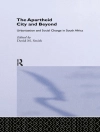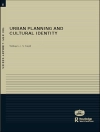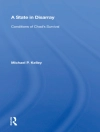This book provides insight into the topic of place and territorial identity, which involves both the dimension of collective belonging and the politics of territorial planning and enhancement. It considers the social, economic and political effects of territorial identity representations among others in terms of mystification, spatial fetishism, and the creation of place and territorial stereotypes. A mixed methodology is employed to research case studies at diverse territorial scales which are relevant to the impact of a variety of factors on place/territorial identity processes such as migration, political and economic changes, natural disasters, land use changes, etc. Visual imagery, constructing visual discourses and living within visual cultures are placed in the foreground and refer to among others the changes and challenges introduced by the Internet and social networks in place/territory representations and self-representations; identity politics and its impact on place/territorial identity representations; discourses in shaping representations and self-representations of territorial/place-based identities related to collective memory, cultural heritage, invented tradition, imagined communities and other key notions.
Daftar Isi
Foreword. Place, Territory and Identities in a Fast-changing World.- Introduction: Dealing With Territorial/Place Identity Representations.- Part I. Constructing Identities: Re-Building Place-Based Relations.- Chapter 1. Living At The Esquilino: Representations And Self-Representations Of A Multi-Ethnic Central District In Rome.- Chapter 2. Shifting Imageries: Gentrification And The New Touristic Images Of The Inner City Of Palermo.- Chapter 3. Place, Identity And Local Music Representation In Touristic Backgrounds Of Romanian Medium-Sized Towns.- Chapter 4. Sentiment And Visual Analysis. A Case Study Of E-Participation To Give Value To Territorial Instances.- Chapter 5. Landscape As ‘Working Field’ For Territorial Identity In Friuli Venezia Giulia Ecomuseums Action.- Part Ii. Representations Of Nations And Cities: Ever-Changing Territorial Identities.- Chapter 6. Sense Of Place As Spatial Control: Austerity And Place Processes Among Young People In Ballymun, Dublin.- Chapter 7. Place-Identity Discourses In “Tunnel Of Time: 10×10 Ten Decades Of Romania In One Hundred Images”.- Chapter 8. Visual Discourse And Urban Spatial Identity In Picture Postcards During Socialist Romania (1948-1989).- Chapter 8. Identification And Interpretation Of The Territorial Identity Elements Of A Small Industrial Town Using Postcards. Case Study: Anina, Romania.- Part Iii. Negotiating Identities And Belonging: State Borders And Internal Migrations.- Chapter 9. Everyday Territorial Identities In Romania And The Republic Of Moldova: A Case Study On The Impacts Of Territorial Representations From Above.- Chapter 10. Past Bordering Practices Modelling Present Representations: Transylvanian Saxons’ Administrative Units And The Chair Of Rupea / Repser Stuhl / Kőhalom Szék.- Chapter 11. There Is Always A Way Out! Images Of Place And Identity For Women Escaping Domestic Violence.- Part Iv. Challenges And Stereotypes: Representing Rural Areas.- Chapter 12. The Green Illusion: Rural Representations And Poverty In Ariège, France.- Chapter 13. Spatial Imaginations As A Form Of Rural Representation. Lessons From Poland.- Chapter 14. Iron Men On Wooden Boats: Connection And Isolation Between Local Culture And The Sea In Coastal Donegal.- Conclusions: Towards A New Agenda For Place/Territorial Identity Research.- Introduction: Dealing With Territorial/Place Identity Representations.- Part I. Constructing Identities: Re-Building Place-Based Relations.- Chapter 1. Living At The Esquilino: Representations And Self-Representations Of A Multi-Ethnic Central District In Rome.- Chapter 2. Shifting Imageries: Gentrification And The New Touristic Images Of The Inner City Of Palermo.- Chapter 3. Place, Identity And Local Music Representation In Touristic Backgrounds Of Romanian Medium-Sized Towns.- Chapter 4. Sentiment And Visual Analysis. A Case Study Of E-Participation To Give Value To Territorial Instances.- Chapter 5. Landscape As ‘Working Field’ For Territorial Identity In Friuli Venezia Giulia Ecomuseums Action.- Part Ii. Representations Of Nations And Cities: Ever-Changing Territorial Identities.- Chapter 6. Sense Of Place As Spatial Control: Austerity And Place Processes Among Young People In Ballymun, Dublin.- Chapter 7. Place-Identity Discourses In “Tunnel Of Time: 10×10 Ten Decades Of Romania In One Hundred Images”.- Chapter 8. Visual Discourse And Urban Spatial Identity In Picture Postcards During Socialist Romania (1948-1989).- Chapter 8. Identification And Interpretation Of The Territorial Identity Elements Of A Small Industrial Town Using Postcards. Case Study: Anina, Romania.- Part Iii. Negotiating Identities And Belonging: State Borders And Internal Migrations.- Chapter 9. Everyday Territorial Identities In Romania And The Republic Of Moldova: A Case Study On The Impacts Of Territorial Representations From Above.- Chapter 10. Past Bordering Practices Modelling Present Representations: Transylvanian Saxons’ Administrative Units And The Chair Of Rupea / Repser Stuhl / Kőhalom Szék.- Chapter 11. There Is Always A Way Out! Images Of Place And Identity For Women Escaping Domestic Violence.- Part Iv. Challenges And Stereotypes: Representing Rural Areas.- Chapter 12. The Green Illusion: Rural Representations And Poverty In Ariège, France.- Chapter 13. Spatial Imaginations As A Form Of Rural Representation. Lessons From Poland.- Chapter 14. Iron Men On Wooden Boats: Connection And Isolation Between Local Culture And The Sea In Coastal Donegal.- Conclusions: Towards A New Agenda For Place/Territorial Identity Research.
Tentang Penulis
Tiziana Banini is Associate Professor of Geography at Sapienza University of Rome, Italy. In 2012 she gained the National Scientific Qualification as Full Professor in Geography. She is the National Coordinator of the Research Group of A.Ge.I. (Association of Italian Geographers) on ‘Territorial Identity’ (since 2008). Her main research interests are in territorial identity, socio-cultural processes, local development and participative processes, environmental issues and problems.
Oana-Ramona Ilovan is Associate Professor of Geography at Babeș-Bolyai University, Cluj-Napoca, Romania. She is the founder and editor-in-chief of the scientific journal Territorial Identity and Development (since 2016) and the Director of Territorial Identities and Development Research Centre. Her main research interests are regional geography, territorial identity, qualitative methodology, cultural landscapes, participative processes and urban development.












